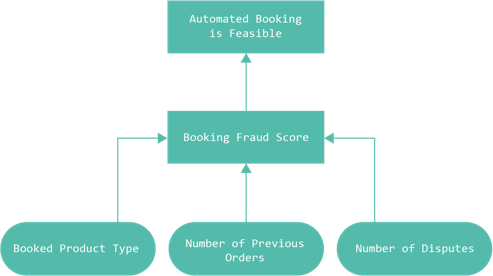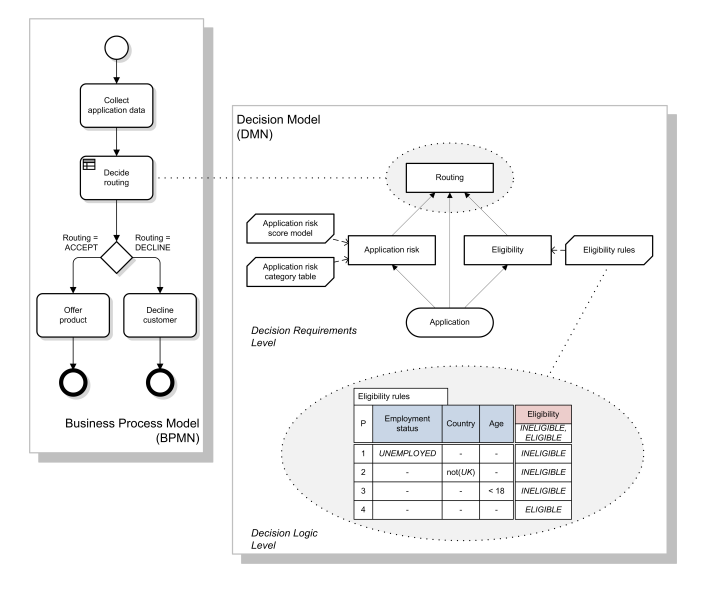Decision Modeling (DMN)
The value and adoption of decision modeling have accelerated since the Decision Model & Notation (DMN) open standard was published by the OMG in 2015.
A decision model depicts business logic with two views. The first, a decision requirements diagram, captures the relationships between parts of your decision-making logic.

The second, a decision logic model, defines that logic, typically using a decision table.


These two views work together to formalize, structure and automate business decision-making.
Using decision modeling, you can:
- Express business logic that is both meaningful to the business and executable.
- Consequently, this creates a single ‘prime record’ for business requirements that is both comprehensible to the business and deployable to a run-time system.
- The representation eliminates the errors that occur when translating specifications to implementation code.
- It puts the business subject matter expert and business analyst in the driving seat creating a more effective collaboration between business experts and IT personnel.
- It enables test-driven development of decisions. The executable nature of decision models allows them to simulate business logic against test data, enabling business users to ‘kick the tires’ of their decisions.
- Quickly identify which data your decisions really need.
- Sketching a decision model is the quickest way to determine what data you actually need and the required data quality (i.e., latency, accuracy, completeness) to support decision-making.
- Decision modeling therefore makes data provisioning more accurate: avoiding the cost of over-provisioning and the delays of late discovery of missing vital data items.
- Perform impact analysis.
- Because decision modeling focuses on the dependencies between decisions, sub-decisions, authorities and data, it allows a rapid assessment of the business and technical impact of changes to these things.
- Helps businesses to assess the true cost of internal change and the impact of externally imposed change.
- Enables CI/CD allowing it to support agile methodologies
- Make implicit business knowledge explicit.
- Decision modeling helps to reveal and address any flaws or inconsistencies in the accepted wisdom of decision-making.
- The technique includes means of discovering decisions that are ‘hidden in plain sight’.
- Commoditize business knowledge.
- Decision modeling offers a vehicle for companies to buy and sell business expertise (e.g., regulatory standards, legal constraints, industry conventions).
- Standardize and integrate your decision with business process modeling (BPMN). All Business Analysts and tools will use the same format to represent decision modeling.
Sweet Spot
Decision modeling can be beneficial in many areas, particularly areas needing to handle:
- High value
- High transparency
- Scalability

Real-World Decision Modelin g with DMN, James Taylor and Jan Purchase, 2023
OMG Example
The OMG provides this example to show how decision modeling can be used with BPMN and decision tables. Here you can see how a decision model to accept/decline an application is used within a business process – and a decision table is used to specify the logic for eligibility with the decision model.

Further Reading
- Real-World Decision Modeling with DMN, James Taylor and Jan Purchase, 2023
- DMN Method & Style, Bruce Silver, 2018
- Decision Automation Organization
- Decision Management Community